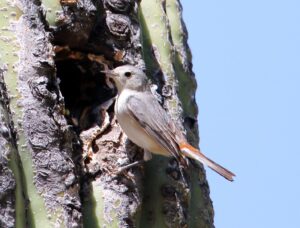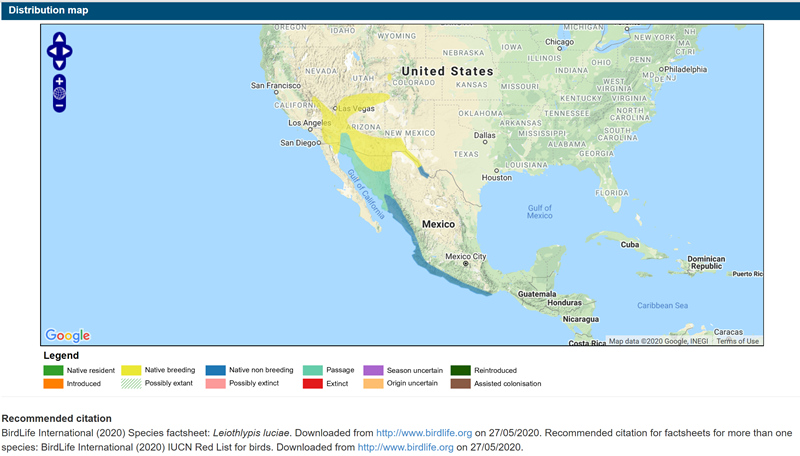Contents: Species, Interesting Facts, Identification, Song, Distribution, Preferred Nesting Habitat, Diet, Nesting Behavior, Nestboxes, Nestbox Location, Recommended Distance Between Nestboxes, Monitoring, Nesting Timetable, Longevity, More Info

Species: Leiothylpis luciae, also listed as Oreothlypis luciae. Common name: Lucy’s Warbler, Desert Warbler, Mesquite Warbler.
- There are only two species of warblers that nest in cavities – the Prothonatory Warbler and Lucy’s Warbler.
- Named for Lucy Hunter Baird, daughter of ornithologist Spencer Fullerton Baird.
- Sometimes they hang upside down while searching for food.
- Courting males drop their wings to show off their cinnamon rump patch, and also raise their cinnamon crown feathers when singing and chasing females.
- The only warbler that nests in the hot deserts of the Southwestern U.S.
- Populations are stable.
Identification: A very small (about 4″ long), compact, delicate songbird with a short tail and short, thin, pointy bill. White eye ring. Adult males are grayish overall, with a cinnamon rump and small (hard to see) crown patch. Adult females are duller pale gray, with a rump or crown that is often yellowish brown/yellow, with a plain face and faint buffy wash on the flanks. Juveniles have a tawny rump and buffy wingbars.
They are sometimes confused with Colima Warbler and Virginia’s Warbler or gnatcatchers.
Song: Males sing all spring. Song is a perky whee-tee, whee-tee, whee-tee, wheet-tee, wheet.
Distribution: Southwestern U.S. and NW Mexico. As mesquites are cut and river’s dry up, their habitats are changing, and populations are decreasing across much of their range.
Preferred Nesting Habitat: Nests in riparian desert stands of mesquite (especially in suburban settings), tamarisk, acacia, hackberries, and willows, especially along stream beds. May also nest in cottonwood, and at higher elevations in dry, open forests with ash, walnut, sycamore, (invasive) tamarisk, and oak. Up to five pairs can nest in an acre of dense mesquite woodlands, often near a stream bed.

Diet: Mostly insects. They hop and forage acrobatically high up in small trees (moving like a chickadee), looking for small insects. They also catch insects on the ground. Occasionally catch insects in mid-air. The few studies of their diet show they eat small beetles (flower/tiger/ground), caterpillars, bugs, leafhoppers, ants, bees, wasps and spiders. They probe buds and flowers but are not known to drink nectar.
Nesting Behavior: They may use woodpecker holes, bark gaps (especially bark peeled from a trunk by fire)old nests (e.g., of Cliff Swallows), streambed crevices (e.g., in a deserted Verdin nest or hole in an eroded stream bank), rock crevices and dense vine tangles.
Nestboxes: Some studies are underway looking at use of artificial nestboxes. Lucy’s Warblers are NOT attracted by rectangular nestboxes. Experimental tube-shaped boxes 10 inches high with a triangle shaped cubby and an entrance on each side (for ventilation) are being used by the Tucson Audubon Society, with an occupancy rate of 75%. The front panel is 2″x3″ and has a hole on the front that is 1.25″ in diameter. It is rectangular, and 7″ deep, with a hinged side panel for monitoring. You may need to keep nestboxes covered outside of nesting season to prevent hives.
Nestbox Location: In cavities and crevices, usually less than 8 feet off the ground, but sometimes up to 20 feet. (Audubon.org says 5 to 40 feet off the ground, Tuscon Audubon says 3 to 36 feet.) Sometimes found in yards in Arizona. Tucson Audubon is placing boxes 8.7 feet off the ground. Mount them in dense foliage with plenty of shade for shelter. Ideally put it on or near a mesquite tree, on the east or south side to avoid the heat of the afternoon sun.
Recommended Distance between Nestboxes: Males may sing 100 feet apart, but they appear to defend a linear territory of about 600 feet. May have as many as 5 pairs per acre.
Monitoring: The Tuscon Audubon society requests that people register their boxes at www.nestwatch.org. Ensure that house sparrows or starlings or mice do not invade nestboxes. Bees or wasps can be a problem – wait until cold morning (when bees are not active) and plug up a hive/cover it in a burlap sack and then submerge in water. Scrub out the inside of the nestbox with soap and water so future bees are not attracted. More info at http://www.americanbeecontrol.net/, http://www.azpest.com/bee_control.asp, http://www.essentialpest.com/residential-bee-removal/ . Eggs or young may be preyed on by lizards, snakes, woodrats and Gila woodpeckers. Cowbirds also parasitize their nests.
- Excavation or nest site selection? Breeding generally in April through June.
- Nest construction: The female builds the nest. (Audubon.org says both sexes build the nest.) Loose and ragged construction of coarse grass and weeds, bark strips, mesquite leaf stems, surrounding a compact cup of fine grasses lined with animal hair or feathers. If using a woodpecker hole, it may fill the cavity nearly to the top with debris, and put the nest on top so it can look out.
- Egg laying: 3 to 7 eggs (usually 4 to 5) in a clutch. Eggs are creamy white with fine reddish-brown spots concentrated at the large end.
- Incubation: Both parents incubate the eggs. 10-12 days or Period unknown?
- Hatching: Nestlings are naked. Spring heat waves can endanger young birds in the nest.
- Development: Both parents feed the young.
- Fledging: Age unknown?
- Dispersal: After fledging, small family groups may hang out together. After breeding, they oven move to wetter habitats during July-August. They winter in Mexico and sometimes in mesquite and tamarisk in the Big Bend region of Texas.
- Number of broods: Possibly 2 per year?
- Longevity: The oldest bird trapped and banded to date was 5 years 10 months (Arizona, Patuxent Wildlife Research Center, Longevity Records)
References and More Information:
- Nest and Egg ID (with links to species biology and photos of nests, eggs and young) for other small cavity nesters
- Prothonatory Warbler Bio
- https://www.allaboutbirds.org/guide/Lucys_Warbler/lifehistory
- https://www.audubon.org/field-guide/bird/lucys-warbler
- https://en.wikipedia.org/wiki/Lucy%27s_warbler
- https://www.audubon.org/magazine/summer-2019/arizonans-are-helping-desert-warbler-expand-its
- Lucy’s Warbler fact sheet: http://tucsonaudubon.org/wp-content/uploads/2018/07/LUWA-factsheet.pdf
- Donate to the Tuscon Audubon Lucy’s Warbler project at https://tas.z2systems.com/lewshorst
– The Beatles
